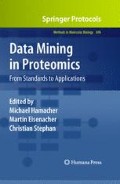Abstract
Proteomic experiments can be difficult to handle because of the large amount of data in different formats that is generated. Samples need to be managed and generated, data needs to be integrated with samples and annotation information. A laboratory information management system (LIMS) can be used to overcome some of the data handling problems. In this chapter, we discuss the role of a LIMS in the proteomics laboratory, and show two step-by-step examples of usage of the Proteios Software Environment (ProSE) to handle two different proteomics workflows.
Access this chapter
Tax calculation will be finalised at checkout
Purchases are for personal use only
References
Hamacher M, Stephan C, Meyer HE, Eisenacher M (2009) Data handling and processing in proteomics. Expert Rev Proteomics 6:217–219
Piggee C (2008) LIMS and the art of MS proteomics. Anal Chem 80:4801–4806
Häkkinen J, Vincic G, Månsson O, Wårell K, Levander F (2009) The proteios software environment: an extensible multiuser platform for management and analysis of proteomics data. J Proteome Res 8:3037–3043
Stephan, C., Kohl, M., Turewicz, M., Podwojski, K., Meyer, H.E., Eisenacher, M (2010) Using laboratory information management systems as central part of a proteomics data workflow. Proteomics 10:1230–1249
Martens L, Hermjakob H, Jones P, Adamski M, Taylor C, States D et al (2005) PRIDE: The proteomics identifications database. Proteomics 5:3537–3545
Thompson A, Schafer J, Kuhn K, Kienle S, Schwarz J, Schmidt G et al (2003) Tandem mass tags: a novel quantification strategy for comparative analysis of complex protein mixtures by MS/MS. Anal Chem 75:1895–1904
Orchard S, Taylor C, Hermjakob H, Zhu W, Julian R, Apweiler R (2004) Current status of proteomic standards development. Expert Rev Proteomics 1:179–183
Martens, L., Chambers, M., Sturm, M., Kessner, D., Levander, F., Shofstahl, J., et al. (2010) mzML – A community standard for mass spectrometry Mol Cell Proteomics doi:10.1074/mcp.R110.000133
Kessner D, Chambers M, Burke R, Agus D, Mallick P (2008) Proteowizard: open source software for rapid proteomics tools development. Bioinformatics 24:2534–2536
Elias JE, Gygi SP (2007) Target-decoy search strategy for increased confidence in large-scale protein identifications by mass spectrometry. Nat Meth 4:207–214
Levander F, Krogh M, Wårell K, Gärdén P, James P, Häkkinen J (2007) Automated reporting from gel-based proteomics experiments using the open source Proteios database application. Proteomics 7:668–674
Reidegeld KA, Eisenacher M, Kohl M, Chamrad D, Korting G, Blueggel M et al (2008) An easy-to-use Decoy Database Builder software tool, implementing different decoy strategies for false discovery rate calculation in automated MS/MS protein identifications. Proteomics 8:1129–1137
Wilkins MR, Appel RD, Van Eyk JE, Chung MCM, Gorg A, Hecker M et al (2006) Guidelines for the next 10 years of proteomics. Proteomics 6:4–8
Taylor CF, Paton NW, Lilley KS, Binz P-A, Julian RK, Jones AR et al (2007) The minimum information about a proteomics experiment (MIAPE). Nat Biotechnol 25:887–893
Author information
Authors and Affiliations
Editor information
Editors and Affiliations
Rights and permissions
Copyright information
© 2011 Springer Science+Business Media, LLC
About this protocol
Cite this protocol
Häkkinen, J., Levander, F. (2011). Laboratory Data and Sample Management for Proteomics. In: Hamacher, M., Eisenacher, M., Stephan, C. (eds) Data Mining in Proteomics. Methods in Molecular Biology, vol 696. Humana Press. https://doi.org/10.1007/978-1-60761-987-1_5
Download citation
DOI: https://doi.org/10.1007/978-1-60761-987-1_5
Published:
Publisher Name: Humana Press
Print ISBN: 978-1-60761-986-4
Online ISBN: 978-1-60761-987-1
eBook Packages: Springer Protocols

